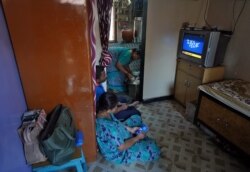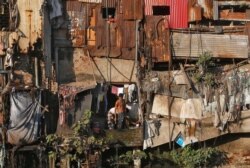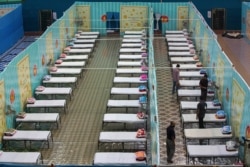Komal Godiwal, who works as a cleaning lady in several homes in a business hub adjoining the Indian capital, has been struggling to cope in her tiny two-meter by three-meter room where she lives with her husband and four children.
“We have to go out to use the shared toilet and to fill up water for cooking,” she said.
Two or three members of the family curl up at night on the one bed in the room, the rest sleep on mattresses on the floor.
The call on Indians not to step out of their homes for three weeks as the country races to contain the coronavirus includes some 65 million people packed into tiny low-income tenements and tin-roofed shanties in squalid urban slums.
Since announcing the lockdown last Tuesday, Prime Minister Narendra Modi has stressed the importance of social distancing, warning that the infection could spread like “wildfire” if there was a single misstep.
In densely populated metropolises like Delhi and Mumbai, though, only the middle class and the affluent can heed the clarion call of physical distancing and isolation because they have the luxury of private spaces.
Cheek-by-jowl living
For those on the lower rungs of the economic ladder, cheek-by-jowl living is the grim reality and staying two meters apart is not an option.
Komal Godiwal’s family shares a toilet with seven other families. Water is filled at community taps and clothes are washed there. Her husband steps out to buy rations at the neighborhood grocer because, unlike the country’s middle class, she did not have enough cash reserves to stock up on food and does not know how to get online deliveries.
Still, she could count herself more fortunate than many.
For Mumbai’s 5 million slum residents there is one toilet for every 190 persons. In its largest slum Dharavi, featured in the Oscar-winning movie, Slum Dog Millionaire, the population density is 280,000 per square kilometer and the lanes are so narrow that it is difficult to pass through without rubbing shoulders.
Public health experts warn that these could be “potential hot spots” for the infection.
These densely packed settlements highlight the challenges facing a developing country like India in getting a grip on the pandemic. The unprecedented lockdown while cases were still relatively small has been praised. Whether the country wins or loses the battle it is waging, however, will depend on controlling it in such areas.
'Time bomb'
Alarm bells have sounded in Mumbai after more than 10 people living in densely packed low-income areas and slums tested positive for the infection in recent days.
“I think we are sitting on a time bomb,” said Rajmohan Panda, a health expert at the Public health Foundation of India.
“There has to be an effort on a war footing to supply water of good quality in a manner that enables them to practice some sort of hygiene. For example, you can position water tankers and temporary hand-washing stations in the slums. You have to provide them the resources to fight the infection,” Panda said.
India has recorded more than 1,250 cases of coronavirus and 32 deaths. Officials say the infection still has not entered the stage of community transmission when numbers spike exponentially, but several public health experts believe that is inevitable.
“We are managing to contain it where the lockdown is working efficiently. But intra-cluster spread is happening and if you don’t monitor this, at the end of 21 days, the virus will get out,” warned T. Jacob John, former head of the Indian Council for Medical Research’s Centre for Advanced Research in Virology.
Noting that not enough planning went into plugging “leaky, densely packed points,” he says more attention should be focused on raising awareness about coronavirus transmission in such areas.
Experts are calling on India to widen testing that has focused so far on those with travel histories, or those showing symptoms in densely populated low-income settlements that could emerge as the next frontier.
The lives of middle-class India intersect closely with those living in low-income settlements — tens of thousands who work as cleaning women, maids, cooks and drivers in their homes are vulnerable and could carry the infection into their crowded communities. India has one hospital bed for 2,000 people.
“If community transmission begins happening, then it is going to be a very difficult journey for the health system to tackle,” said Panda. “Many of those living in low-income areas are undernourished and their immunity levels are low. This is going to be a huge problem, especially if poverty levels rise due to loss of livelihoods.”
Few options
However, for many poor people, those worries dwarf concerns about contracting coronavirus or living in cramped spaces.
Sahin, who gives only one name, lives in a temporary shelter with three others near New Delhi. He makes about $120 a month picking up garbage from city homes — work he continues, as garbage collection has been deemed an essential service.
He wears a thin mask but heaps trash into his cart with his bare hands and then ferries it to a municipal truck.
The last few days have been tough for him, and not because of the health risks he runs working with minimal protective gear. The extra money he made by sifting through the garbage and selling trash that has been recycled has been suspended due to the lockdown. It is posing a challenge as prices surge for vegetables and food rations.
Does Sahin have concerns about the falling sick? The answer is quick and short. “So, what if I worry? Do I have an option to carrying on with my work?”











